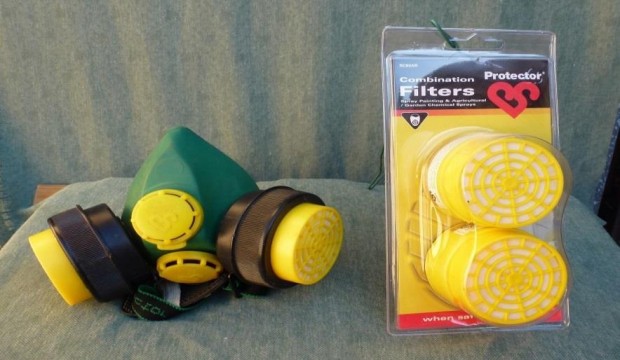Using Pesticides and Fungicides SAFELY
The death of orchid growers from cancer of the liver, is of concern to me and should be of concern to all users of chemicals. There is no need for a blas’e attitude in the use of chemicals on orchids, as there is so much information available on how to use them safely.
With the death of four orchid growers in the Bundaberg area, all with cancer of the liver, the alarm bells were ringing. I found out that they did most of their spraying in shorts and short sleeve shirts, one did not wear shoes. They mostly wore masks, but not always agricultural chemical ones.
I made a stupid mistake when I sprayed a glass house with Metasystox without a respirator. It took about ten minutes to spray the plants and the same amount of time, for me to be near collapse.
- Head spinning
- Dry mouth
- Co-ordination not good
- Lack of breath
It took over half an hour till things started to right themselves and 24 hours to be feeling ok again. I learnt my lesson. Chemicals are to be respected.
- All chemicals are at their most dangerous, when being put in the spray tank. Powders float in the air and without a proper agricultural mask are easily inhaled. Liquid chemicals are easily spilled, protection should be used, PVC gloves, Mask, protective clothing and water-proof boots. If contact is made with the skin, wash immediately with soap.
APPLICATION SAFE GUARDS
Safe clothing…
- Wear protective clothing
- Water proof- agricultural suit
- Rain coat and pantsNormal/ordinary clothing absorbs the spray and the intake of poisons through the skin more likely to cause health problems, with a build-up in the fatty tissues of the body (Chronic poisoning). Hot weather is the more likely time for entry into the body of poisons, when the skin is wet with perspiration, pores of the skin are open, up take would be at its maximum.
Mask Protection …..
- Always use a face mask for Agricultural use, with a cartridge or cartridges fitted for Chemicals (agriculture)
- Wear eye protection, it is very easy for the chemicals to enter through the eyes.
- Wear water proof shoes (gumboots)
- Elbow length PVC gloves. Protective clothing should fit on the outside of the gumboots.
- Two things to note:
- Spray early morning or late afternoon, when it is cool and less likely to be windy, spray shade houses on a calm day if possible to stop the drift of the spray, glass houses etc., can be closed up if it is windy if you want to spray on a windy day. Re-enter a sprayed area only after toxic fumes have dispersed-no smell takes about 2 to 3 days, should you have to go in wear a mask.
- Tell someone that you are going to spray…
- If you can smell the chemical then the mask is not doing its job.
- If your eyes burn, the spray could be entering through this area, eye protection should be worn.
SYMPTOMS of POISIONING….
- Collapsing
- Convulsing
- Cramps
- Diarrhoea
- Difficulty in breathing
- Dizziness
- Loss of co-ordination
- Nausea
- Nervousness
- Sleepiness
- Salivation (excessive)
- Staggering,
- Tremor
- Unconsciousness
- Vomiting
- Burning eyes
- Dryness in the mouth Take the container and label with the patient, so the doctor can identify the poison and contact the nearest Poison Control Centre.
COMPATIBILITY….
Preventive spraying programs may lead to phytotoxity in the plants. Injury to plants can occur, so use them with great caution. Observe precautions regarding temperatures at which to apply, frequency of application and rates of use. This can cause leaf scorch, necrotic spotting, abnormal pigmentation, stunting of plants, crippling of leaves and crippling of flowers.
STORAGE OF PESTICIDES…..
Never put the pesticides into smaller containers, original containers are designed to filter out ultraviolet light. Wettable powders are usually in humidity-shielded bags.
DISPOSAL OF PESTICIDES AND CONTAINERS…….
- Keep pesticides and fungicides in a locked cupboard, well ventilated and out of direct sunlight. Reseal any open containers. Put a sign on the door “PERTICIDES- NO ENTRY”.
- Read the label for any special storage requirements. Make sure the label is in good condition, so you know what is in the container, the mixing requirements and use by date.
EXCESSIVE USE….
- Mixing of fungicides, insecticides or any combinations of them I DO NOT RECOMMEND. There is no way of knowing, especially for the hobby grower, if toxicity increases or decreases. You could be making a very lethal mixture, not only for yourself, but also for your neighbours, the lasting qualities could be affected. Damage to plants could also occur and what each chemical was intended for by the maker may not do it’s job or over do it’s job.
WHAT TO DO IF POISONING DOES OCCUR….
Unwanted pesticides and fungicides, including surplus in a spray tank, should be diluted and disposed of in a soakage pit. All containers should be rinsed twice and added to spray tanks or soakage pit. Do not use empty containers for any purpose. Containers should be crushed and buried, preferably in a land fill dump. (D.P.I. Pesticide Manual)
If you handle plants……
- Wear gloves, should you handle them bare handed
- Wash your hands immediately. The spray residue build up on the leaf surfaces, pots etc. The spray is toxic for some time, (3 days) then slowly decreases for unknown periods, depending on the spray.
- I always wear shoes in the orchid house as a safe guard against the residue of sprays that could be on the floor
- Do not allow children in your orchid house, after spraying, they like to play in the sand etc., actually they should be kept out so as to save the plant tags, flowers etc.
- When buying plants at shows or nurseries, ask if they had been sprayed recently? If they have been, with what? Remember, you will be handling them when you take them home!
- If the mask is used frequently, they are good for six months. This type of mask is the minimum protection for the use of Insecticides, Pesticides and Fungicides. White dust masks do not protect you.
Agriculture Safety Double Cartridge Mask with replacement cartridges….
Face Mask…
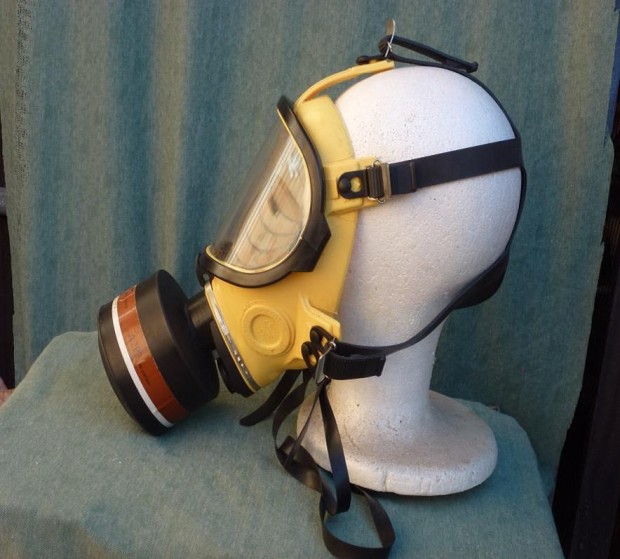
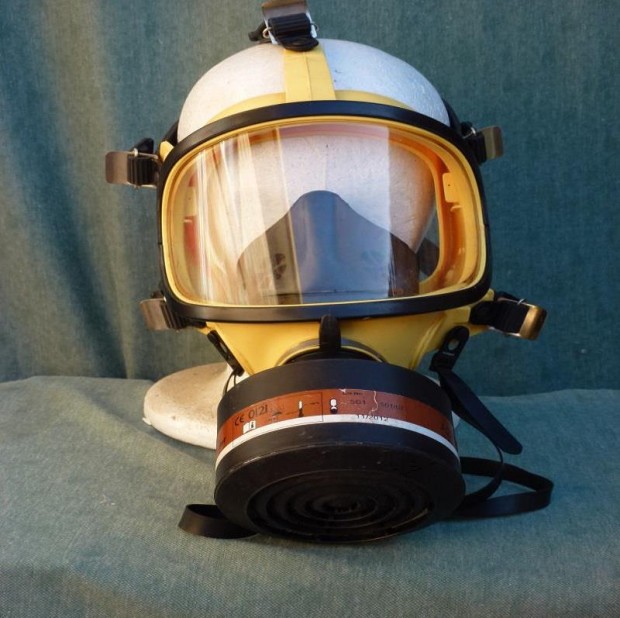 This type of Face Mask covers the whole face, mouth, eyes and nose. It has only one cartridge. It is top of the range and cost around $300. You need to use it in the cool time of day, as it seals your face so well, you will fog the mask with perspiration.
This type of Face Mask covers the whole face, mouth, eyes and nose. It has only one cartridge. It is top of the range and cost around $300. You need to use it in the cool time of day, as it seals your face so well, you will fog the mask with perspiration.
This is a Full Hood Mask ….
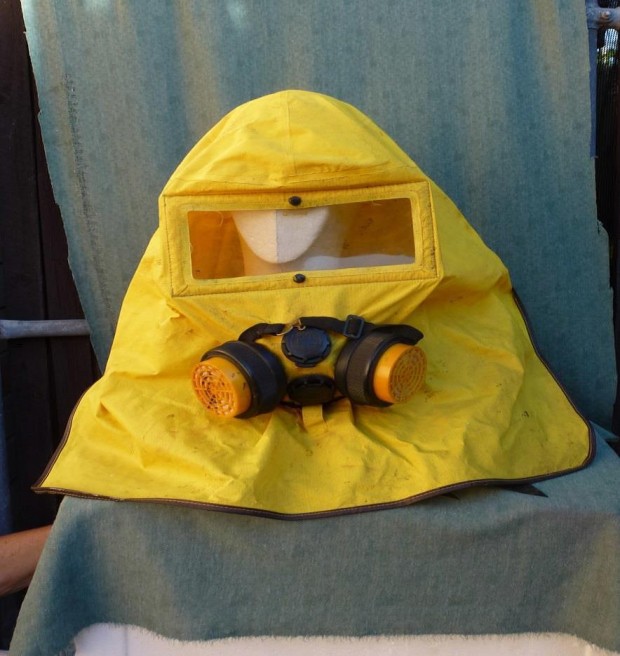 Two cartridges. The mask is actually the same as the first one with a hood attachment. It can also get hot and cool time of day is the best time to use it. It will fit inside your protective clothing which seals it off very well. I use all three, depending on the severity of the product that is being used. Yes, it can be a nuisance putting on the safety gear, but it will save your life, there is no doubt about that.
Two cartridges. The mask is actually the same as the first one with a hood attachment. It can also get hot and cool time of day is the best time to use it. It will fit inside your protective clothing which seals it off very well. I use all three, depending on the severity of the product that is being used. Yes, it can be a nuisance putting on the safety gear, but it will save your life, there is no doubt about that.
All dressed up with nowhere to go. ……
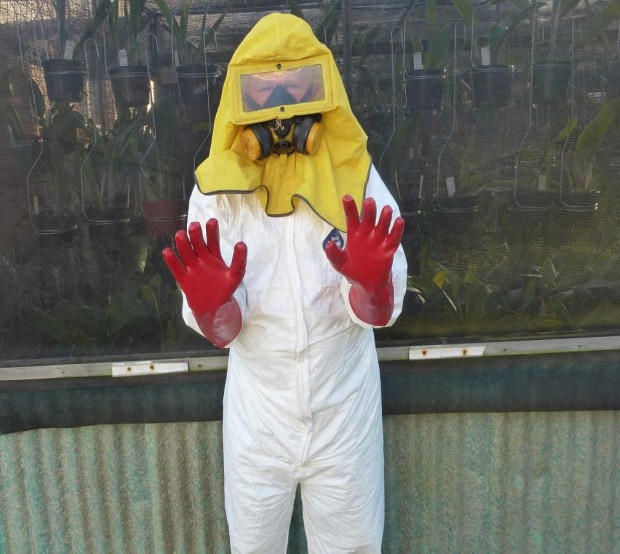
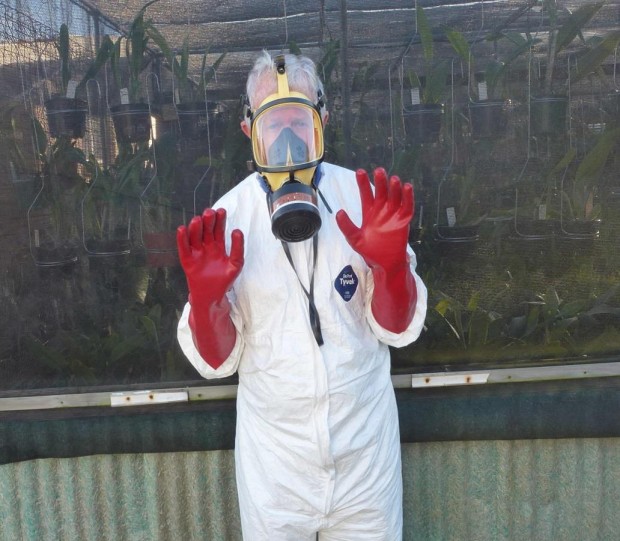 The gloves are PVC which are the best protection. The protective suit is very light weight, it has a zipper up the front and also a hood, if needed. The end of the arms and legs have elastic to fit firmly. The feet have Gum-boots for covering.
The gloves are PVC which are the best protection. The protective suit is very light weight, it has a zipper up the front and also a hood, if needed. The end of the arms and legs have elastic to fit firmly. The feet have Gum-boots for covering.
After spraying , as soon as you can, a bath or shower is a must.
COMPATIBILTY ….
I do not recommend the mixing of any chemicals, with the cost of these products you need to get the best results, not taking a short cut by mixing them together, with no way of knowing if they give the results claimed by the maker. If they have different PHs to get the best results from them, if you mix them do you take a guess at the PH. Will the combination make the spray more toxic, will it affect the plants.
PHOTOTOXICITY…………
This is the damage caused by Chemicals being incorrectly used. Only apply in the early morning, before 8am, not in the heat of the day. Stick to the makers recommendations, do not use excessive amounts of the products. Mixing products can cause burns to the leaves, flowers, new eyes and roots. Can cause varying colours of green to the leaves.
POOR RESULTS ….
- Product is out of date. Two years is normal shelf life.
- Wrong PH
- Not the right product for the problem
- Not compatible. (If mixing chemicals)
- Not used at the makers recommended rate
PH of water can decrease or increase the lasting period and product quality of Insecticides, fungicides and fertilizers. PH is a measure of the acidity or alkalinity of water, soil or potting mix. It has a range of 0 to 14. A PH of 7 is neutral, with readings below 7 being increasingly acid, while above 7 increasingly alkaline. Have you ever experienced less than adequate pest control, even though you have applied the pesticides, fungicides and fertilizers, according to the directions on the label. It is often attributed to factors such as insect resistance, poor timing or poor application techniques. Another factor that is now receiving particular attention is the PH of the water, used in the preparation of the spray solution. Many pesticides solutions, particularly carbonates and organophosphates, loose their effectiveness in an alkaline (PH>7.0) water by a process called “ALKALINE HYDROLYSIS”. This process causes the pesticide molecules to split into inactive or non active compounds. The rate of decomposition depends on the pesticide involved and the alkalinity of the water. Thus a pesticide may begin to break down as soon as it is added to the spray tank, causing it to be less effective or even totally ineffective, for control of pests.
If you allow a spray mix to stand for a couple of hours or even over-night before using it, 50% or more of the active ingredients may be decomposed under alkaline conditions. The net result is poor pest control. The following is the results of tests on the effectiveness and PH influence of certain insecticides and fungicides.
![]()
